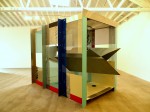Sometimes I look at art and can’t help but think of the famous acronym: W.T.F.
As strange as it seems, I gravitate toward art because I don’t always know what it means; it’s interesting without needing a reason. Today, art can be just about anything – bizarre, beautiful, ugly, boring, obscene and even meaningless – all of which are definitions implied by the artist and justified through audience interpretation. With so many diverse views, art is considered to be a very accepting field, yet at the same time there’s a pretentious air about art, artists and those who identify with art.
I don’t really consider myself to be an artist, artsy person or art expert. I’m one of those people who enjoy walking through galleries with their head tilted slightly to the side, wondering what it is they’re looking at. Is it a foot? Is it Glenn Coco’s face? I’m never really sure, but that combination of wonder and mystery is exactly what I find exhilarating about art. As I write each week about my different experiences at various galleries, I hope to encourage people to view things without thinking too hard and to see art just as it is, not what it’s trying to be.
This brings me to the first gallery I attended this year, which I came upon by accident. After encountering a few fender benders from my first driving experience in Los Angeles, I found myself stranded in a parking lot across the street from a 99-cent store, conveniently adjacent to the Marc Foxx gallery and a few others.
The small galleries located on Wilshire kept me entertained for a good hour or so, but I found the Marc Foxx had the most curious collection of wacky sculptures. The gallery featured Los Angeles-based artist Jason Meadows, who is known to work with different mediums from wood, metal and fabric to randomly found objects like baseball gloves, wigs, shoes, etc. In this case, he primarily used aluminum sheets to construct eye-catching shapes and colors with ambiguous meanings.
Out of the three sculptures in the gallery, the largest one stood out to me the most. The structure was rectangular with open ends on each side, accented with a cold palette of colors like aqua, blue and gray that gave off a calming oceanic vibe. Hanging on the inside of the box were two smaller, slanted rectangles with sharp open ends.
When viewing this rectangular mass of metal, W.T.F. came to mind again. “Why the fish?” I thought to myself, because in the sculpture I saw the panels of metal forming two fish in a tank. Later on, after reading the press release, I found the title of the work was “Sea of Love” and the metal on the inside of the rectangle was supposed to represent two sharks.
Aside from feeling good about myself for seeing what the artist intended, I thought about how I saw two sharks from what appeared to be metal plates. I realized most things we see on a regular basis are shapes deviated from their basic geometric forms – circles, squares and triangles. A shark is a very pointy creature, with a pointed nose and fins. Its whole appearance is made up of points and curved lines, but when you take away the curvature and simplify the shark, it looks a lot like what Meadows portrayed it to be: a sharp, diagonal gray polygon. But why does this all matter? Sure it’s an interesting way to look at a shark, but how is it even relevant? I don’t even like sharks. If you’re asking yourself a similar question, you might be missing the point (no pun intended). Meadows is an artist who enjoys working with his own imagination on objects or creatures that exist in the real world. “Sea of Love” isn’t supposed to evoke profound thought; it’s an expression of creative perspective.
When looking at art, first view it without figuring out its significance. If you find the art is causing a specific emotion, that’s great. If your interpretation of it is exactly what the artist intended, ten points for you. But if you find yourself wondering what it means, then take that curiosity and run with it. You might be surprised with where you end up.
Have you seen any intriguing pieces of art that changed your perspective on reality? Email Shin, who’s always looking for quirky art at jshin@media.ucla.edu.
